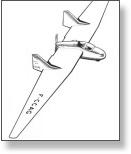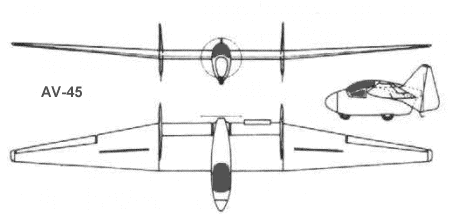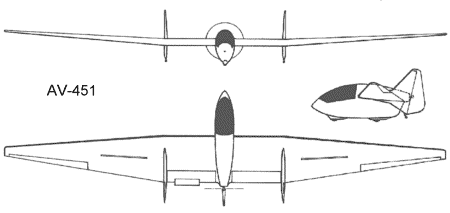| http://www.survol.cjb.net |
|
|
|
|
AV-45 / AV-451
 |
 |
 |
| AV-45 prototype
F-CCAG on ground and in flight |
||
 |
 |
 |
| Drawing of the AV-45 |
The
AV-45 remotorized |
AV-451 in flight |
| (click on the pictures to enlarge them in a new window) | ||
Inspired by two previous German experiences of motorizing the AV-36, and greatly motivated by the concept of the motorglider, Charles Fauvel flew the new AV-45 in 1960, an AV-36 very modified and powered by a pusher Nelson motor of 37 HP. The second improved prototype, built by the SAN (Société Aéronautique Normande) in Bernay, took off with Charles Fauvel in command in 1962. This copy was equipped with a Solo engine of 23 HP that permitted, in spite of its low power output, enough power to take off in less than 100 ms and to climb at up to 3 m/sec. The first prototype served also for tests of the Microturbo "Eclair" (Lightning) jet engine of 68 kgps, making possible a 4 m/sec climb. The prohibitive price of this jet engine did not allow its use for practical reasons, however.
The first AV-45 motorglider of amateur construction, equipped with a Solo engine, was constructed in Japan and flew in South Africa, while several copies were begun in the United States, in Finland, Germany and Spain. In France alone, even though some copies were constructed by amateurs, most glider pilots remained for the most part unconvinced of the charms of this motorglider. Not discouraged, Charles Fauvel further improved the motorglider with the AV-451 version. This ship had its span extended to 15 m, incorporated a new airfoil design from Wortmann : the Laminar FX 66-H 159, a new fuselage shape obtained by using an existing glass canopy design (the one on the Grob Astir glider), and with streamlined wheels. The propeller was automatically folded rearward by airflow effect when the engine was stopped. Another example was constructed in Baccarat by the Gross brothers which was rigged with a Rotax 2-cycle engine of a 40 Horsepower. It made its first flight in the beginning of September 1978. Endowed with a L/D of 32:1, the AV-451 was the last flying wing of Fauvel. An entirely fibreglas composite version (AV-48) had been considered, but a fire at the shop where the prototype was to be constructed put an end to this adventure.
The death of Charles Fauvel explains in part the fact that the AV-451 didn't attain the success of the AV-36 and AV-361. It is also necessary to also take note of the fact that at this time, glider pilots were more interested in heavier machines, which offered better penetration in the air, and that the concept of the motorglider was rejected by glider purists who represented the then-current majority thought. Besides, few light and reliable engines were available on the market. And finally, it is also necessary to state that, like all machines of Charles Fauvel, the AV-45 and AV-451 were victims of certain glider pilot’s prejudices, more so than a proper critical analysis of his designs.
| Characteristics and performance of the AV-45 and AV-451 | ||
| AV-45 | AV-451 | |
| Wing span | 13.75 m | 15.00 m |
| Length | 3.60 m | 3.84 m |
| Wing area | 14.80 m2 | 16.68 m2 |
| Airfoil | Fauvel F4 17% | Wortmann FX-66 H 159 |
| Aspect ratio | 10.80 | 13.5 |
| Empty weight | 219 kg | 250 kg |
| Maximum gross weight | 350 kg | 380 kg |
| Glide ratio | 26:1 | 32:1 |
| Min sink rate | 0.82 m/sec | 0.72 m/sec |

